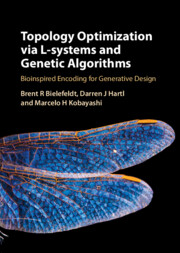 Topology Optimization via L-Systems and Genetic Algorithms
Topology Optimization via L-Systems and Genetic Algorithms Book contents
- Frontmatter
- Contents
- 1 Introduction
- 2 Review of Topology Optimization Methods
- 3 Introduction to L-systems and Turtle Graphics Interpretation
- 4 Spatial Interpretation for the Development of Reconfigurable Structures (SPIDRS)
- 5 Arrangement L-system Interpretation
- 6 Multiphysical Applications
- Appendix A Vector Spaces
- Appendix B Classical Methods in Optimization
- Appendix C Classical Simplex-Based Approach to Ground Structure Optimization
- Appendix D Increasing Structural/Networking Feasibility in Turtle-Constructed Graphs
- Appendix E Conversion of Graphs to Volumetric Bodies for Three-Dimensional Analysis and Additive Manufacturing
- References
- Index
- References
References
Published online by Cambridge University Press: 13 June 2025
- Frontmatter
- Contents
- 1 Introduction
- 2 Review of Topology Optimization Methods
- 3 Introduction to L-systems and Turtle Graphics Interpretation
- 4 Spatial Interpretation for the Development of Reconfigurable Structures (SPIDRS)
- 5 Arrangement L-system Interpretation
- 6 Multiphysical Applications
- Appendix A Vector Spaces
- Appendix B Classical Methods in Optimization
- Appendix C Classical Simplex-Based Approach to Ground Structure Optimization
- Appendix D Increasing Structural/Networking Feasibility in Turtle-Constructed Graphs
- Appendix E Conversion of Graphs to Volumetric Bodies for Three-Dimensional Analysis and Additive Manufacturing
- References
- Index
- References
Summary

Information
- Type
- Chapter
- Information
- Topology Optimization via L-Systems and Genetic AlgorithmsBioinspired Encoding for Generative Design, pp. 281 - 292Publisher: Cambridge University PressPrint publication year: 2025